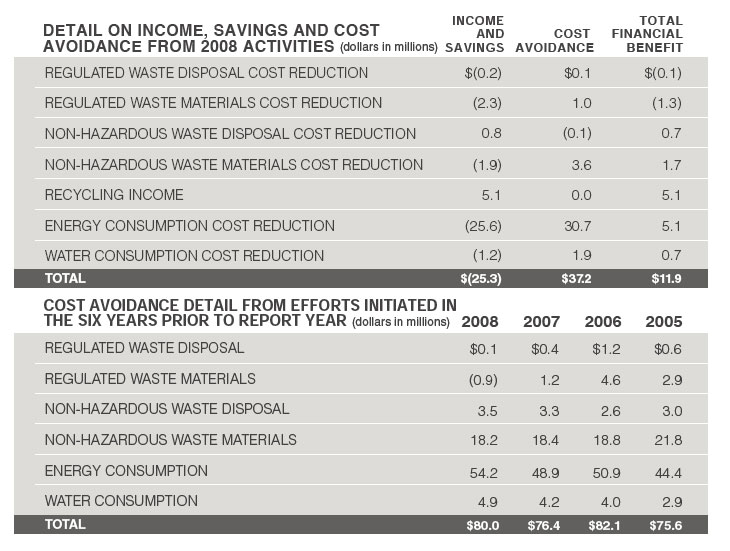Healthcare products giant Baxter International is among the increasing number of companies to release annual “Sustainability” reports, and the recently released version for 2008 is among the most comprehensive available. It details that Baxter added $11.9 million to the bottom line from Sustainability initiatives in 2008, bringing the total to over $80 million over the past six years. Baxter has also reduced Greenhouse Gas (GHG) emissions by 21% indexed to the company’s revenue since 2005.
Surprisingly, the 2008 Baxter report is the 10th version, making Baxter among the pioneers in Sustainability reporting.
Baxter has set ambitious goals for Greening its supply chain by 2015, which include:
- Reduce the carbon footprint of Baxter’s car fleet by 20% from 2007 baseline
- Incorporate green principles into Baxter’s purchasing program with its top 100 suppliers (by spend).
- Reduce greenhouse gas emissions 45% indexed to revenue from 2005 baseline.
- Increase facility energy usage of renewable power to 20% (of total).
- Reduce total waste generation 30% indexed to revenue from 2005 baseline.
- Reduce energy usage 30% indexed to revenue from 2005 baseline.
- Eliminate 5 million kilograms (5,000 metric tons) of packaging material from products sent to customers from 2007 baseline.
- Reduce water usage 35% indexed to revenue from 2005 baseline. To help achieve this, by 2010 evaluate potentially vulnerable watersheds associated with Baxter facilities and establish aggressive water conservation goals for high-risk areas.
- Implement two projects to help protect vulnerable watersheds and/or provide communities with enhanced access to clean water.
- Incorporate the following elements as appropriate into Baxter's product stewardship programs: sustainable design, takeback and recycling of Baxter's products.
Baxter’s bottom line savings for 2008 and cumulative totals for the past six years are summarized in the graphic below.
Where the Savings Come from Green at Baxter

Reduced energy consumption clearly represents the largest component of these bottom line benefits, and much of that comes from improvements in manufacturing and logistics operations.
For example, Baxter has implemented numerous enhancements since 2004 to its private truck fleet, such as installing onboard computers, which helped reduce idle times from 10 percent to 2 percent, and capping fleet speeds at 62 miles per hour. In 2009, Baxter will upgrade onboard computer systems, enhance fleet delivery routing software and introduce two diesel hybrids to the Renal fleet. The company projects that these changes, combined with ongoing upgrades, will reduce fleet emissions 18-20 percent in 2009 compared to 2008, in addition to reducing fuel consumption.
It also requires all of its surface transport providers to participate in the U.S. Environmental Protection Agency SmartWaySM program.
Modal shifts are also a key part of the mix. Shifting from more to less energy-intensive modes of transport such as truck to rail also reduces emissions. Baxter says it has increased the use of intermodal transport (rail and truck combined as opposed to truck only) in the United States every year since 2005, reducing greenhouse gas emissions by 530 metric tons carbon dioxide equivalent (CO2E) in 2008. In Europe, shifting from truck to other modes of transport reduced GHG emissions by more than 1,580 metric tons CO2E in 2008.
On the procurement front, Baxter also says it has modified its request for proposal document to cover information about suppliers' sustainability commitment, initiatives and performance, and also added sustainability language to its standard supplier agreement. The company plans to incorporate that language into similar documents in all other locations in 2009. Baxter also will include sustainability criteria in its global supplier scorecards for direct suppliers.
Packaging improvement also play an important role. For example, in 2008 the company reduced the packaging size for the majority of U.S. Renal solution cartons. With a reduction of 360 metric tons of corrugated packing in the second half of 2008, they hope to realize a decrease of 800 metric tons in 2009.
Water efficiency is another core element of Baxter's Green supply chain efforts. For example, its Grosotto, Italy, facility reduced water consumption by 116 million liters (14 percent reduction compared to 2007) through sterilizer water recovery and cooling water optimization projects. In total, Baxter's water consumption dropped 1 percent in 2008 from 13.9 million cubic meters in 2007 to 13.7 million cubic meters in 2008. Water use has fallen nearly 7.2 percent since the baseline year of 2005.
From 2005 to 2008, Baxter decreased net GHG emissions on an absolute basis from 743,000 to 738,000 metric tons carbon dioxide equivalent (C02e). This includes total offsets of 37,000 metric tons CO2e for 2008 (4.8 percent of total emissions from operations). During this same period, the company reduced net GHG emissions indexed to revenue by 21 percent, achieving its original 2010 GHG emissions goal two years early and remains on target to meet its 2015 goal of a 45 percent decrease.
All that said, the $11.9 million in savings represents just .09% of the company’s more than $12 billion in 2008 revenue and .59% of net income for the year – figures companies need to ponder as they weight ROI from Green initiatives.
The full report is available here: Baxter 2008 Sustainability Report.
What is your reaction to Baxter’s latest Sustainability report? Do Green initiatives really have a compelling ROI? Let us know your thoughts at the Feedback button below.
|